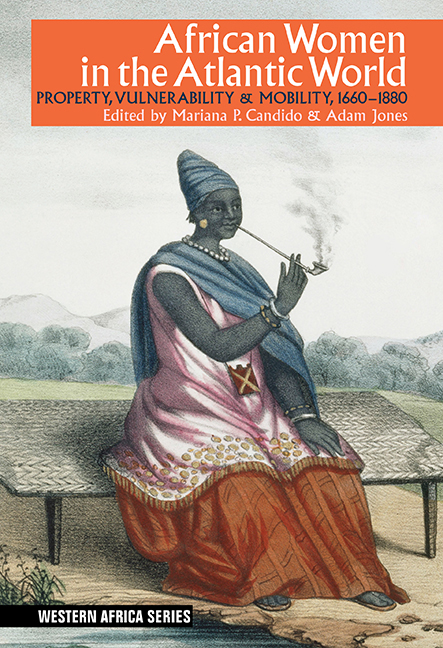Book contents
- Frontmatter
- Contents
- Acknowledgements
- List of Illustrations
- Contributors
- Map 1 Western Africa
- Introduction
- Part One Property
- Part Two Vulnerability
- Part Three Mobility
- 9 From Child Slave to Madam Esperance One Woman's Career in the Anglo-African World c. 1675–1707
- 10 Writing the History of the Trans-african Woman in the Revolutionary French Atlantic
- 11 Spouses & Commercial Partners Immigrant Men & Locally Born Women in Luanda 1831–1859
- 12 Women, Family & Daily Life in Senegal's Nineteenth- Century Atlantic Towns
- Bibliography
- Index
9 - From Child Slave to Madam Esperance One Woman's Career in the Anglo-African World c. 1675–1707
from Part Three - Mobility
Published online by Cambridge University Press: 26 March 2019
- Frontmatter
- Contents
- Acknowledgements
- List of Illustrations
- Contributors
- Map 1 Western Africa
- Introduction
- Part One Property
- Part Two Vulnerability
- Part Three Mobility
- 9 From Child Slave to Madam Esperance One Woman's Career in the Anglo-African World c. 1675–1707
- 10 Writing the History of the Trans-african Woman in the Revolutionary French Atlantic
- 11 Spouses & Commercial Partners Immigrant Men & Locally Born Women in Luanda 1831–1859
- 12 Women, Family & Daily Life in Senegal's Nineteenth- Century Atlantic Towns
- Bibliography
- Index
Summary
A young Luso-African child slave named Esperança (Hope) arrived at England's Royal African Company (RAC) fort on James Island in the Gambia River in the early 1680s. Precisely who took her there, who gave her the name Esperança, and whether she was a captive or born into slavery, are all unknowns. We learn of her approximate age from English court and parish records, which suggest she was born in about 1675. She became a child slave of the RAC employee John Booker, whose time of arrival at the James Island fort is also uncertain. The first mention of him in the RAC account books comes in December 1680. A major change in staffing at the fort on 31 August 1683 brought Alexander Cleeve to the top position of company agent with Booker as his ‘second’, promotions that would situate both men at the centre of RAC trading operations on West Africa's Upper Guinea Coast. During the late seventeenth century, when the company enjoyed a monopoly of English trade in Africa, Anglo-African commerce in Upper Guinea was organised primarily by the James Island agent and his assistants. Atlantic commerce and the socially fluid, multi-cultural world it generated would mark in very particular ways the lives of Booker, his child slave Hope, and others living on and around the island. This chapter focuses on the life and travels of Hope and what her experiences can reveal about social and economic prospects and constraints faced by Euro-African women in the early modern era. Those who attained high status, designated by titles such as senhora or signare, illustrate the career paths open to women as merchants, property owners and slave holders in Atlantic Africa.
James Island
Lying barren and exposed at the mouth of the Gambia River, this small, rocky outcrop was highly prized by merchants from a number of European countries for its strategically important location. The Gambia was a major artery in local and Atlantic trade, connecting inland commercial markets with coastal and maritime traffic (Map 9). Taken into English hands in 1661, James Island developed into an inter-continental trading hub especially after 1677, as the newly formed RAC established a station there and began to staff and supply it regularly.
- Type
- Chapter
- Information
- African Women in the Atlantic WorldProperty, Vulnerability & Mobility, 1660–1880, pp. 171 - 190Publisher: Boydell & BrewerPrint publication year: 2019

